Oct 23, 2025
The Essential Virtual Furniture Staging Guide for 2025
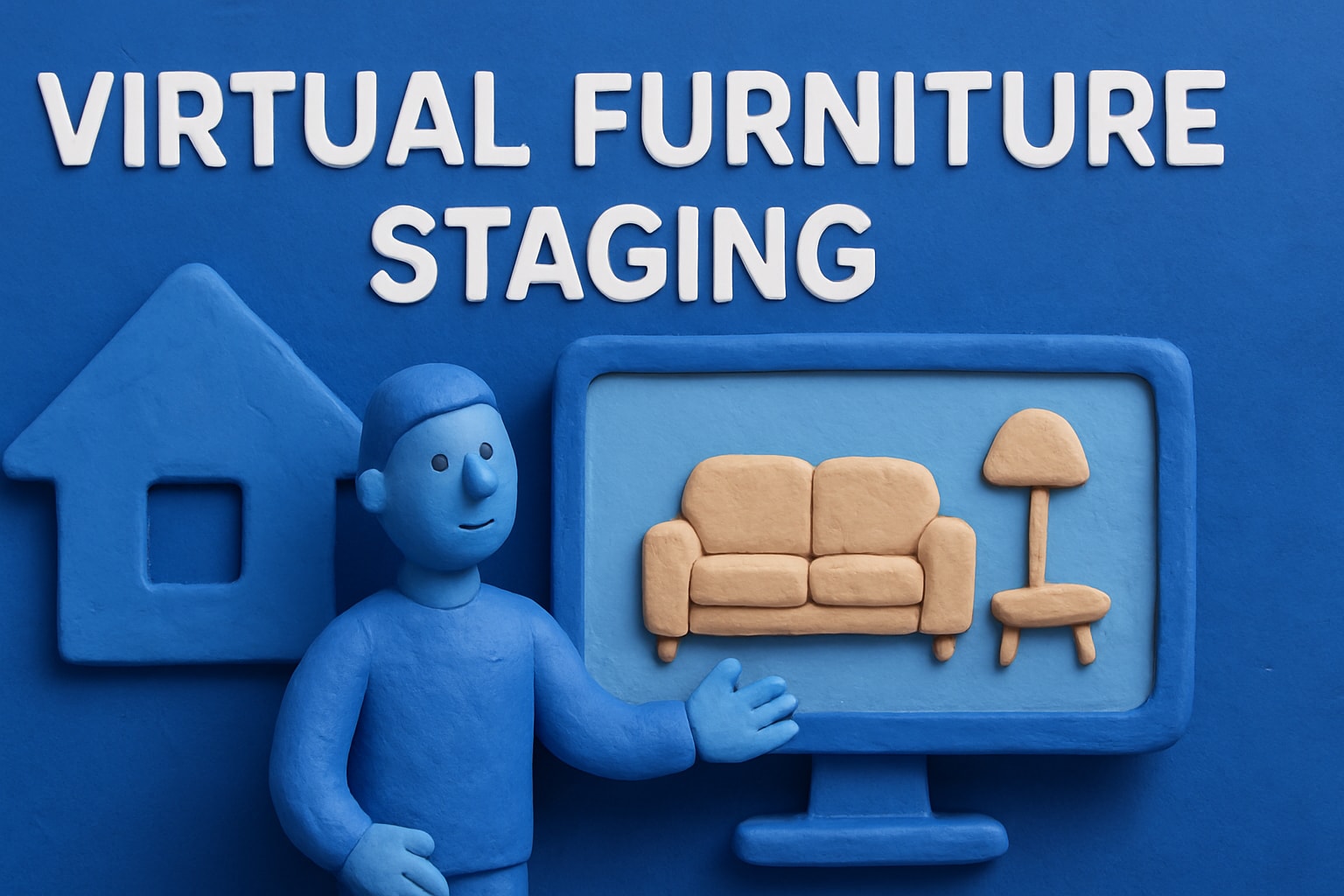
Virtual furniture staging is transforming the real estate market in 2025, unlocking new ways for buyers to experience properties online. The rapid shift to digital-first marketing has made it essential for agents and sellers to stand out.
This guide walks you through every step of virtual furniture staging, from understanding the basics to mastering the latest technology. You will discover the benefits, see industry trends, and learn proven methods for faster sales.
Did you know that staged listings sell 73% faster on average? With impressive ROI and real-world success stories, now is the perfect time to leverage these strategies for your own property marketing.
Get ready to explore how virtual furniture staging can give you a competitive edge and help you achieve outstanding results.
Understanding Virtual Furniture Staging in 2025
Virtual furniture staging has quickly become a cornerstone of modern real estate marketing. In 2025, it refers to the process of digitally furnishing and decorating property photos to create compelling, lifelike interiors. Unlike traditional staging, which requires physical furniture and décor, virtual furniture staging uses advanced software to transform empty rooms with digital furnishings, art, and accessories.
This innovation allows agents and sellers to present properties in their best light, regardless of location or current condition. The technology is particularly powerful for real estate sales, rentals, and commercial spaces. According to recent data, over 80% of buyers report that virtual staging helps them better visualize a property’s potential. The surge in popularity is largely driven by remote buying trends and the need for engaging, digital-first marketing strategies. For those interested in exploring specific applications in real estate, Virtual Staging for Real Estate offers a closer look at how these solutions are transforming the industry.
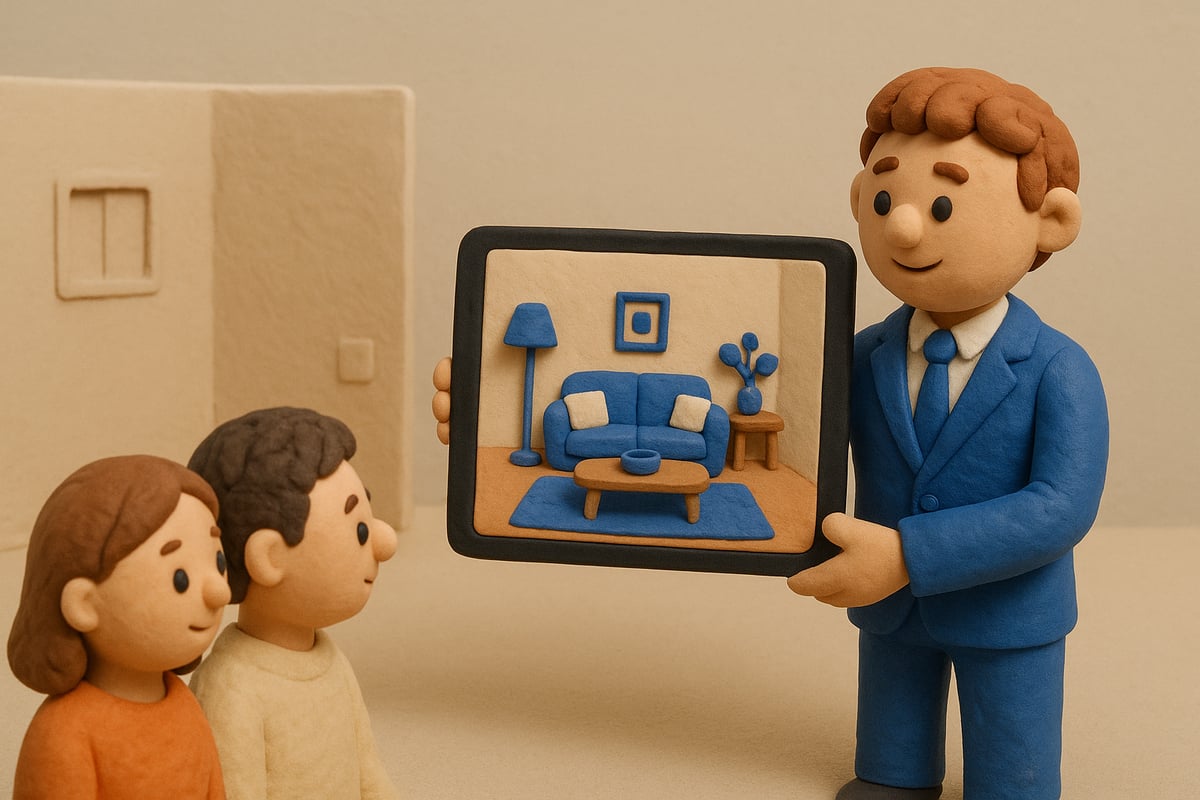
What is Virtual Furniture Staging?
Virtual furniture staging leverages digital tools to create photorealistic interiors from basic property photos. Using specialized software or platforms, professionals can insert virtual sofas, beds, tables, and décor into images of vacant or outdated spaces. This approach enables sellers to showcase a variety of styles and layouts without physically moving any furniture.
Key use cases include residential real estate listings, rental properties, and commercial spaces. Virtual furniture staging is especially valuable when a property is vacant, outdated, or under-furnished. In 2024 and 2025, as remote transactions become more common, the ability to present a fully furnished home online is a game changer. Statistics show that listings featuring virtual furniture staging receive significantly more attention and help buyers imagine themselves living in the space.
Key Differences: Virtual vs. Traditional Staging
When comparing virtual furniture staging with traditional staging, several distinctions stand out. Virtual solutions are typically more cost-effective, with prices ranging from $50 to $200 per image, compared to $2,000 or more for physical staging. The turnaround time is faster, often within 24 to 72 hours, and there is greater flexibility to update or change designs.
| Aspect | Virtual Furniture Staging | Traditional Staging |
|---|---|---|
| Cost | $50–$200 per photo | $2,000+ per home |
| Time | 1–3 days | 1–2 weeks |
| Flexibility | High (easy edits) | Low (physical changes) |
| Scalability | Unlimited | Limited by inventory |
A recent case study highlights a property that sold within days after virtual furniture staging, whereas previous vacant listings had lingered for weeks. However, it’s important to disclose virtual staging and manage buyer expectations, as digital enhancements should not misrepresent permanent features or conditions.
Types of Virtual Staging Services
There are three main categories of virtual furniture staging services: DIY software, professional agencies, and AI-powered platforms. DIY tools offer user-friendly interfaces for agents or homeowners to stage photos themselves. Professional agencies provide custom designs and expert touch, while AI-powered platforms automate much of the process for speed and efficiency.
Pricing models vary, with some charging per room or per property, and others offering subscription plans for high-volume users. Popular platforms distinguish themselves with expansive furniture libraries, quick turnaround, and high-quality rendering. Choosing the right service depends on budget, project size, and desired level of customization.
Who Benefits Most from Virtual Staging?
Virtual furniture staging delivers value to a wide spectrum of real estate professionals. Real estate agents, investors, property managers, and developers all benefit from enhanced listing appeal and faster sales cycles. The technique is especially impactful for vacant, outdated, or under-furnished properties, where visualizing potential is key.
Data from 2024 reports that staged homes sell 73% faster on average, underscoring the effectiveness of virtual furniture staging. By allowing multiple décor styles to be showcased and enabling buyers to visualize renovation possibilities, this approach helps maximize property value and engagement.
The Benefits of Virtual Furniture Staging
Virtual furniture staging is transforming real estate marketing by making properties more appealing, cost-effective, and eco-friendly. Its impact is measurable, with sellers and agents seeing stronger engagement, faster sales, and better returns on investment. What makes this approach so effective? Let us explore the key benefits shaping the industry in 2025.
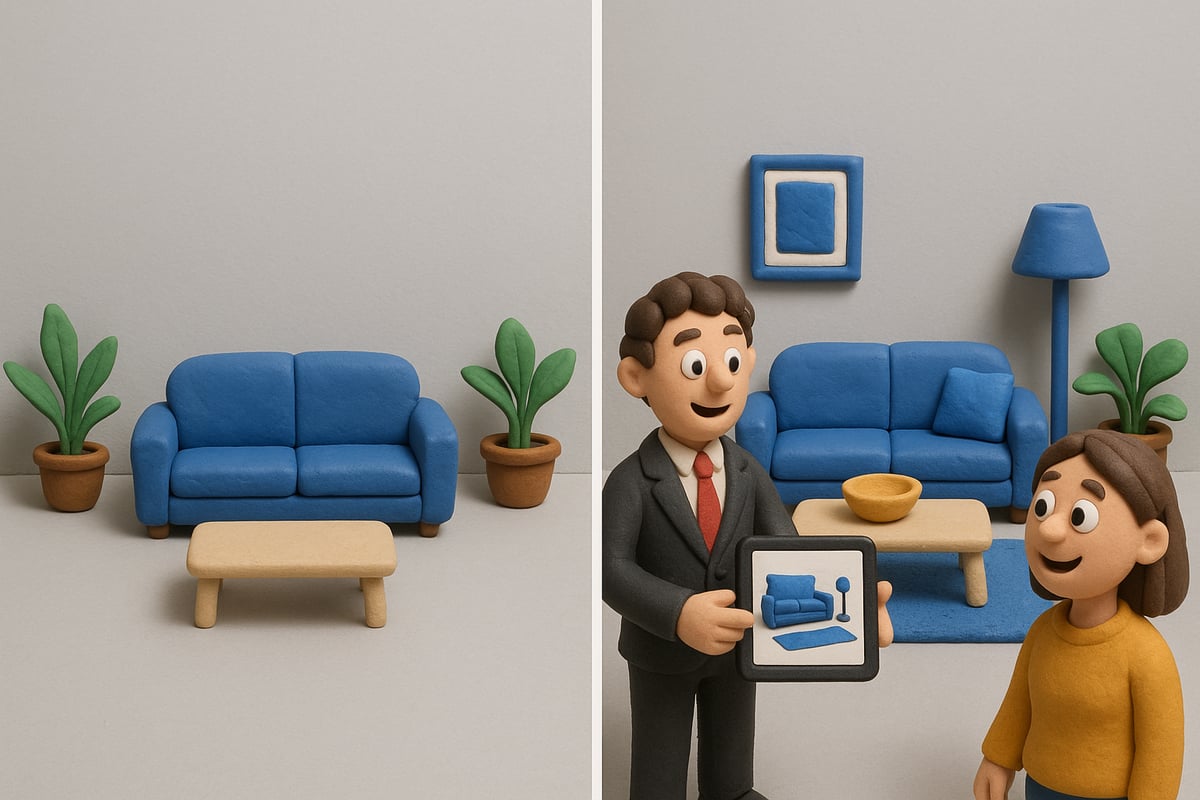
Enhanced Visual Appeal and Buyer Engagement
Virtual furniture staging transforms empty or outdated spaces into inviting, photorealistic homes. Buyers can instantly picture themselves living in the property, which increases emotional connection and interest. Listings featuring virtual furniture staging receive up to twice as many online views compared to unstaged listings.
Before-and-after images not only catch the eye but also boost click-through rates on property platforms. According to Virtual staging statistics 2025, over 80% of buyers find it easier to visualize a home when virtual staging is used.
Cost-Effectiveness and ROI
One of the main advantages of virtual furniture staging is its affordability. Traditional staging often requires significant investment in furniture rental and setup, while virtual solutions minimize these expenses.
| Staging Method | Average Cost per Room | Time Required |
|---|---|---|
| Traditional Staging | $2,000+ | 1–2 weeks |
| Virtual Furniture Staging | $50–$200 | 1–3 days |
Sellers typically see a return on investment of five to ten times their staging spend, making virtual furniture staging an attractive option for maximizing profits and reducing hassle.
Faster Sales and Higher Offers
Homes enhanced with virtual furniture staging spend less time on the market. Staged properties attract more qualified buyers, leading to quicker negotiations and, often, higher sale prices.
In competitive markets, staged listings frequently sell above asking price. Recent data shows that 85% of staged homes sell for 5 to 23% over list price, demonstrating how virtual furniture staging can directly influence both speed and value of sales.
Flexibility and Customization
Virtual furniture staging offers unmatched flexibility for tailoring spaces to different buyer demographics. Agents can showcase multiple décor styles—modern, minimalist, or traditional—for the same property, appealing to a wider audience.
This customization helps buyers visualize renovation potential and see how a space can fit their lifestyle. With virtual furniture staging, real estate professionals can adjust designs quickly to reflect changing trends or feedback.
Eco-Friendly and Logistical Advantages
Choosing virtual furniture staging significantly reduces the environmental impact of property marketing. Without the need for physical furniture, transportation, or storage, the carbon footprint drops considerably.
There are also fewer logistical challenges. Virtual staging eliminates the risk of damage or loss during moves and makes it easier to update spaces as needed, supporting a more sustainable and efficient workflow.
The Step-by-Step Virtual Furniture Staging Process
Mastering the virtual furniture staging process can transform property marketing outcomes in 2025. Each step, from preparing your property photos to integrating staged images into your listings, plays a crucial role in attracting buyers and maximizing ROI. Let’s break down the process so you can achieve professional results.
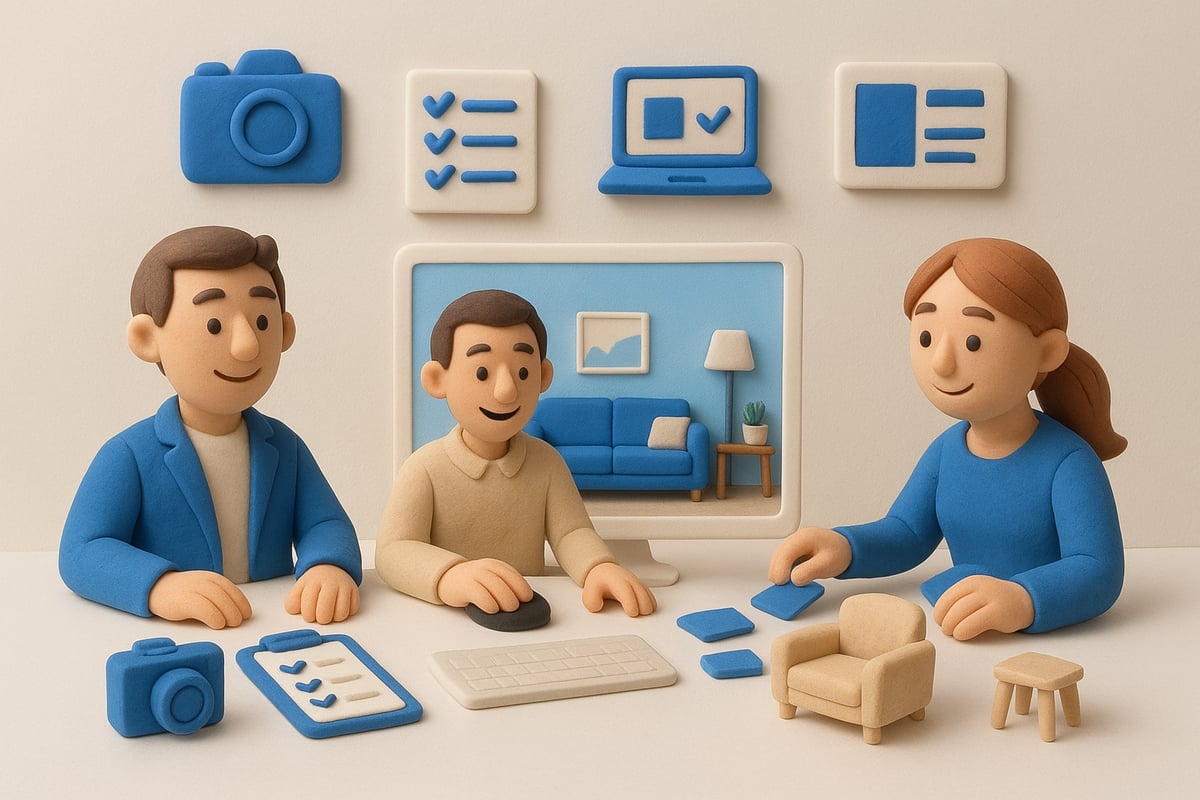
Step 1: Preparing Your Property Photos
The foundation of successful virtual furniture staging is high-quality property photography. Crisp, well-lit images ensure digital furniture appears realistic and inviting. Use a DSLR camera or a new-generation smartphone to capture each room from multiple angles.
Before shooting, declutter all visible surfaces and remove personal items. Open blinds or curtains to maximize natural light, and avoid harsh shadows by shooting at midday. For optimal results, follow this simple checklist:
- Clear all surfaces and floors.
- Open curtains, turn on lights.
- Shoot from chest height, corners preferred.
- Capture every main room and unique feature.
- Use landscape orientation for consistency.
Working with a professional photographer can further enhance results. Tools and services like Photo Editing for Realtors can optimize images before staging, ensuring your virtual furniture staging looks seamless. Always remember, the better your source images, the more impressive your final staged visuals.
Step 2: Selecting the Right Virtual Staging Platform or Provider
Choosing the best platform or provider is essential for effective virtual furniture staging. Evaluate platforms based on image quality, furniture library variety, turnaround time, pricing, and customer support.
Compare leading options using a table like this:
| Feature | Platform A | Platform B | Platform C |
|---|---|---|---|
| Image Quality | High | Medium | High |
| Furniture Styles | 100+ | 50 | 200+ |
| Turnaround | 24 hrs | 48 hrs | 12 hrs |
| Pricing | $$ | $ | $$$ |
Request sample portfolios to assess style and realism. Read client reviews for insight into reliability and service quality. Some platforms offer free trials or sample edits on your photos, making the selection process easier.
Ultimately, select a provider that aligns with your property type, budget, and marketing goals. This careful evaluation will help your virtual furniture staging process run smoothly.
Step 3: Choosing Design Styles and Furniture Sets
Matching staging design to your target demographic is vital. Virtual furniture staging allows you to experiment with modern, minimalist, or traditional décor styles without the cost or hassle of physical furniture.
In 2025, biophilic designs, minimalist layouts, and smart home features are trending. If your property is in a trendy urban area, opt for sleek, contemporary pieces. For family homes, warm and inviting designs tend to resonate more.
Consider the local market and property architecture when selecting styles. For example, a downtown loft may benefit from industrial chic staging, while a suburban home might require cozy, classic arrangements.
Collaborate with your provider to select furniture sets that highlight your property’s best features. This attention to detail ensures your virtual furniture staging appeals to the right buyers and maximizes engagement.
Step 4: Collaborating with Virtual Stagers or Using DIY Tools
Effective communication is key when working with virtual staging professionals or using DIY platforms. Submit high-resolution images, floor plans, and detailed notes about your design preferences.
Share inspiration images, color palettes, and any must-have furniture types. The clearer your brief, the closer the result will match your vision for the property.
DIY tools offer flexibility and control but require a keen eye for design. Professional services, on the other hand, bring expertise in layout, scale, and photorealism. Weigh the pros and cons:
- DIY Platforms: Lower cost, hands-on control, learning curve.
- Professional Services: Higher cost, expert design, faster turnaround.
Choose the approach that best fits your timeline, budget, and desired outcome for your virtual furniture staging project.
Step 5: Reviewing and Refining the Staged Images
Once you receive your staged images, review them carefully for realism and accuracy. Check that furniture is correctly scaled, lighting matches the original photo, and all items look naturally placed.
Common issues include floating furniture, mismatched shadows, or disproportionate pieces. Don’t hesitate to request revisions—most providers include at least one round of edits.
Here’s a typical revision workflow:
- Review each staged image for accuracy.
- List any changes needed (e.g., different sofa color, add plants).
- Communicate feedback clearly and concisely.
- Approve final images for marketing use.
A meticulous review ensures your virtual furniture staging will impress buyers and set your listings apart in a competitive market.
Step 6: Integrating Staged Photos into Marketing
With your virtual furniture staging complete, it’s time to showcase your enhanced images across all marketing channels. Upload staged photos to your MLS listing, real estate website, and social media profiles.
Be transparent about which images are virtually staged by including a clear disclaimer in your listing. This builds trust with buyers and adheres to industry best practices.
For maximum impact, feature staged images as the primary listing photos. Data shows that listings with virtual furniture staging see up to 30% higher engagement on major platforms. Use these images in print materials, email campaigns, and virtual tours to create a cohesive, attractive presentation.
With a strategic approach, virtual furniture staging will elevate your listings and help you achieve faster, more profitable sales.
Best Practices and Legal Considerations for Virtual Staging
Virtual furniture staging has transformed how properties are presented, but success depends on following industry best practices and legal standards. By prioritizing realism, disclosure, and ethical marketing, real estate professionals can maximize the impact of virtual furniture staging while building trust with buyers.
Ensuring Realism and Ethical Marketing
Realism is the cornerstone of effective virtual furniture staging. All enhancements should reflect what buyers will see in person. Avoid manipulating permanent features, such as flooring or wall colors, and never conceal defects. The National Association of Realtors (NAR) and many MLS boards provide clear guidelines on what constitutes ethical virtual staging. For a deeper understanding of AI's role in maintaining these standards, see the Guide to AI Virtual Staging.
Ethical marketing builds trust. Only use virtual furniture staging to add furnishings or decor, not to misrepresent the property. According to recent home staging statistics 2025, buyers are more likely to engage with listings that are both attractive and transparent.
Disclosure Requirements and Transparency
Transparency is a legal and ethical obligation in virtual furniture staging. Always disclose when images have been virtually staged. Use clear language in your listing, such as “Images shown include virtual furniture staging for illustrative purposes.”
Some MLS systems have specific fields for disclosure, while others require a disclaimer in the property description. Failing to disclose can result in legal disputes or loss of credibility. Proactive transparency reassures buyers and sets realistic expectations during property tours.
Optimizing for Different Platforms and Devices
Virtual furniture staging images must look great across web, mobile, and print. Optimize file formats—JPEG for web, TIFF for print—to ensure clarity and fast load times. Maintain image resolution between 1500 and 2500 pixels on the longest side for MLS and major portals.
Test images on multiple devices to verify consistent color and brightness. Since 70% of buyers first view listings on mobile, prioritize mobile optimization. Compress images to avoid slow load times, which can reduce engagement and lower your listing’s ranking.
Protecting Intellectual Property and Usage Rights
When using virtual furniture staging services, clarify who owns the images. Most providers grant a license for marketing, but not for resale or redistribution. Review contracts to confirm permitted uses and avoid copyright disputes.
Do not use stock photos or furniture models without proper licensing. Violating intellectual property rights can lead to costly legal consequences. Always store documentation of your agreements with virtual staging vendors for future reference.
Working with Professional Photographers and Stagers
Collaboration with photographers and virtual stagers leads to the best results. Provide a clear brief detailing the property’s style, target audience, and any specific staging goals. High-quality original photos are crucial for realistic virtual furniture staging.
Photographers can help capture the optimal lighting, angles, and composition. Virtual stagers offer design expertise and can recommend layouts tailored to your market. Teamwork ensures that staged images enhance the listing without misleading potential buyers.
Common Mistakes to Avoid
Avoid over-staging rooms with too much furniture or decor, which can make spaces feel cluttered. Unrealistic furniture scale, poor lighting, and ignoring room proportions can reduce the effectiveness of virtual furniture staging.
Do not digitally remove flaws or permanent features—this is considered deceptive. Solicit feedback from colleagues and clients to catch any issues before publishing. Learning from Virtual Staging Success Stories can help you identify pitfalls and apply winning strategies for your own listings.
Technology Trends and Innovations in Virtual Furniture Staging for 2025
The landscape of virtual furniture staging is rapidly evolving in 2025, driven by advances in artificial intelligence, immersive technologies, and growing market demand. As the industry expands, new tools and platforms are transforming how real estate professionals present properties and engage buyers. According to the virtual staging market forecast, these innovations are projected to fuel significant growth through 2033, making it essential for agents and investors to stay ahead of the curve.
AI and Automation in Virtual Staging
Artificial intelligence is revolutionizing virtual furniture staging with faster, more accurate results. In 2025, AI-powered platforms use deep learning to analyze room layouts, recognize architectural features, and recommend optimal furniture placement. Generative AI can now create highly realistic textures and lighting, making staged images nearly indistinguishable from reality.
Automation tools streamline repetitive tasks such as decluttering, object removal, and adjusting color schemes. Real estate agents can upload property photos and receive professionally staged images within hours. This efficiency allows agents to manage larger portfolios and respond quickly to market demands, keeping virtual furniture staging at the forefront of property marketing.
Weezard AI: Elevating Virtual Staging with Advanced Image Editing
Weezard AI stands out in the virtual furniture staging market for its advanced image editing capabilities tailored to real estate professionals. This platform leverages AI to offer features like automated object removal, instant decluttering, and seamless day-to-dusk transitions. Users can select from a wide range of realistic furniture sets and décor styles, ensuring each staged photo matches the property’s character.
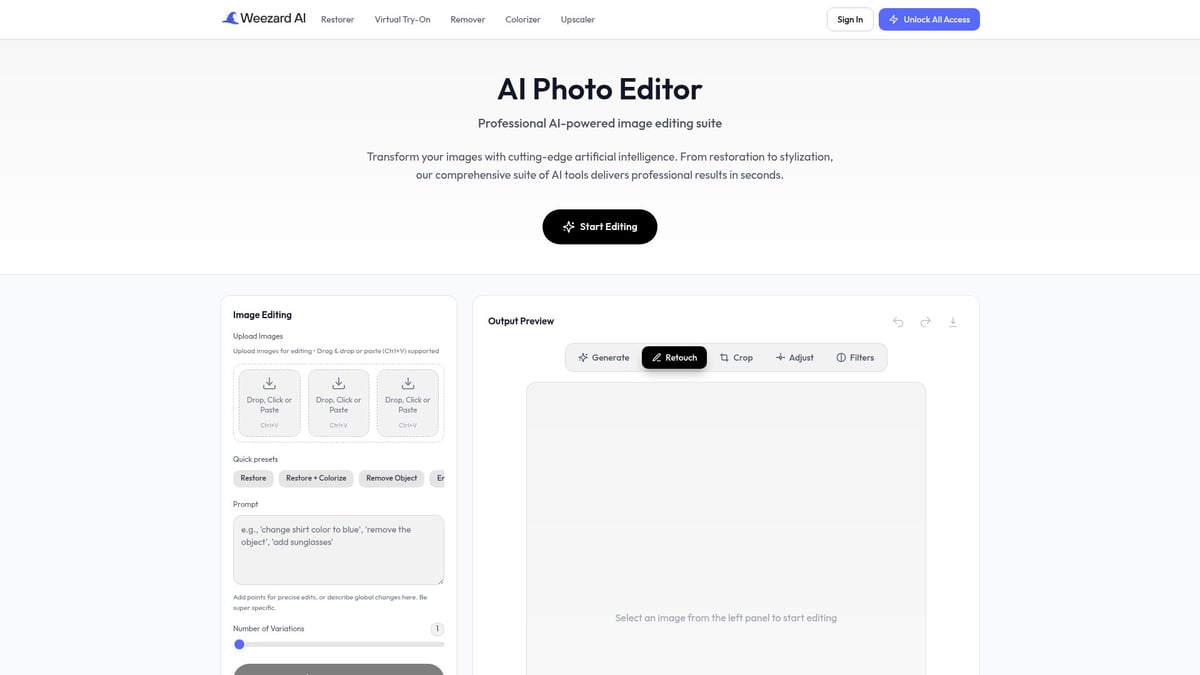
Batch processing allows agents to stage multiple listings efficiently, while the intuitive interface requires minimal technical expertise. Weezard AI also emphasizes ethical virtual furniture staging by maintaining transparency and image quality. For agents seeking consistency and speed, Weezard AI streamlines the staging process while maximizing marketing impact.
Virtual and Augmented Reality Integration
Virtual and augmented reality are pushing virtual furniture staging beyond static images. In 2025, VR allows buyers to explore fully staged 3D walkthroughs, moving from room to room as if they were physically present. AR technology enables potential buyers to use smartphones or tablets to visualize staged furniture overlaid onto real spaces during property tours.
These immersive experiences boost engagement and help buyers form emotional connections with properties. By integrating VR and AR, real estate professionals can demonstrate renovation potential and showcase multiple design styles, making virtual furniture staging more interactive and persuasive than ever before.
Customization and Personalization at Scale
Personalization is a key trend in virtual furniture staging, with platforms now offering tailored staging based on buyer profiles. AI-driven analytics help agents select décor styles that appeal to specific demographics, such as young professionals, families, or retirees. Listings with personalized staging see up to 20 percent higher engagement, as buyers can better envision themselves living in the space.
Customization tools enable staging in various themes, from contemporary to traditional, all within a single listing. This flexibility not only attracts a wider audience but also empowers agents to test different marketing strategies quickly and efficiently using virtual furniture staging.
Future Outlook: What’s Next?
Looking ahead, virtual furniture staging is poised for even greater innovation. Industry experts predict the rise of fully interactive listings, where buyers can rearrange virtual furniture or switch between design styles in real time. Voice-guided staging tours and AI-driven buyer insights will further personalize the property search experience.
As technology continues to advance, staying updated with the latest trends in virtual furniture staging will be crucial for real estate professionals aiming to maintain a competitive edge. Embracing these innovations will help agents deliver exceptional value, drive faster sales, and exceed client expectations in 2025 and beyond.
Now that you’ve explored the benefits, latest trends, and actionable strategies for virtual furniture staging in 2025, you’re ready to elevate your property marketing with confidence. Whether you’re aiming to attract more buyers, speed up sales, or showcase your listings in the best possible light, leveraging innovative AI tools can make all the difference. If you’re curious to see how advanced image editing and virtual staging technology can transform your listings and streamline your workflow, why not take the next step and Make magic!
Ready to jump in?
Experience the power of AI-driven image editing with Weezard AI. Professional results in seconds.

